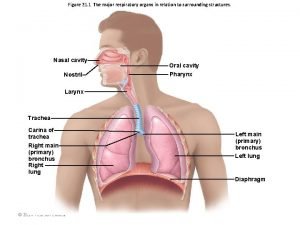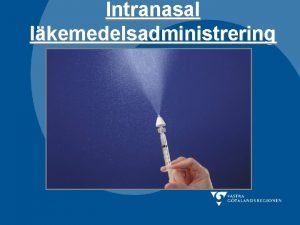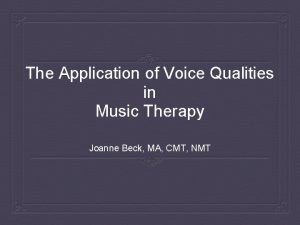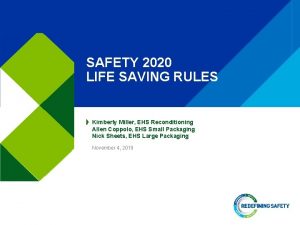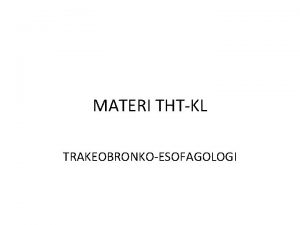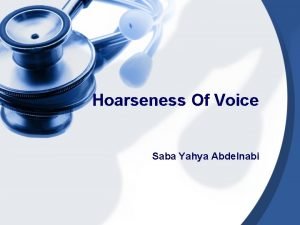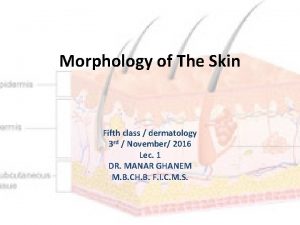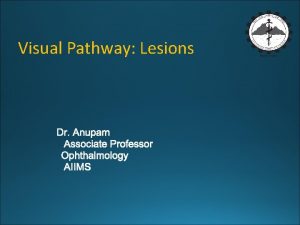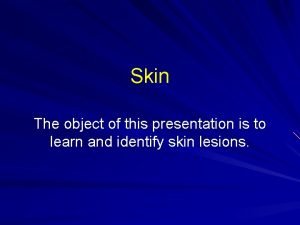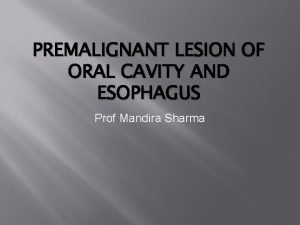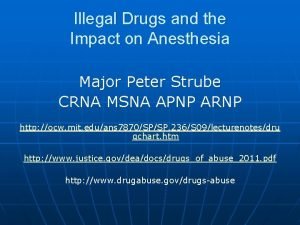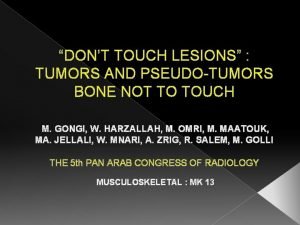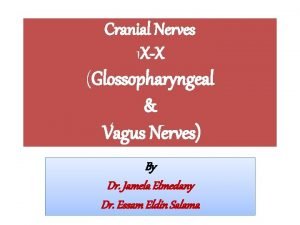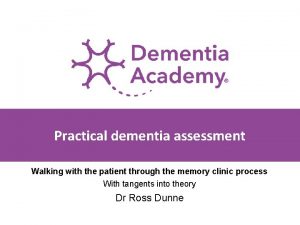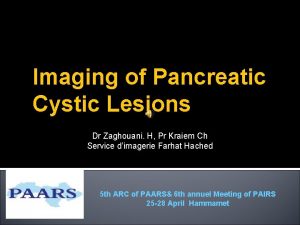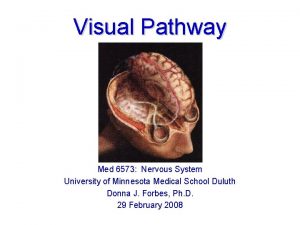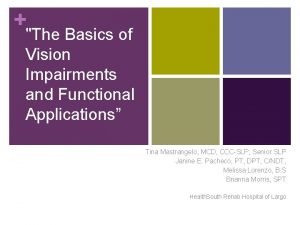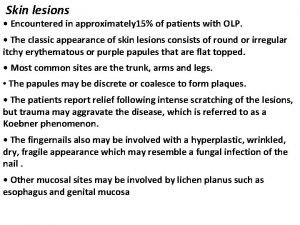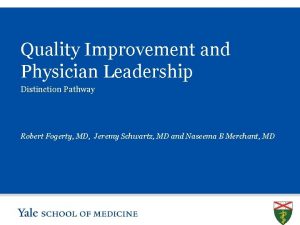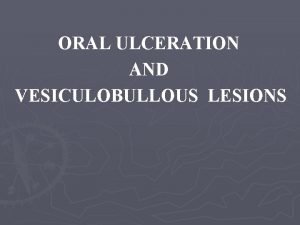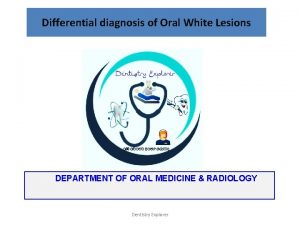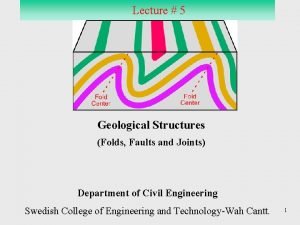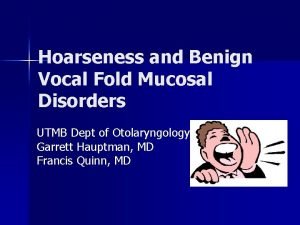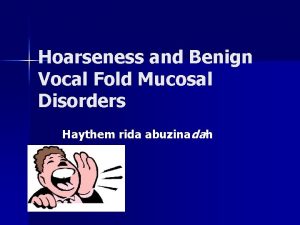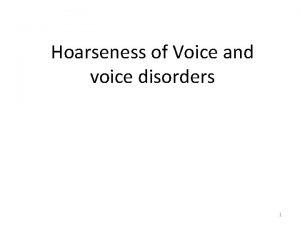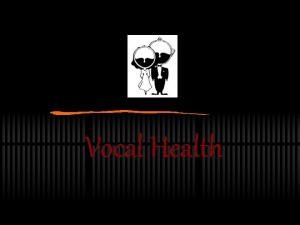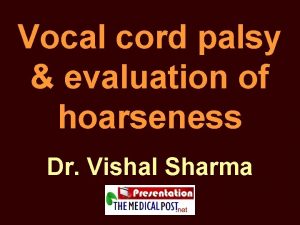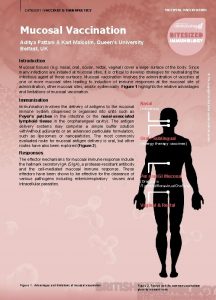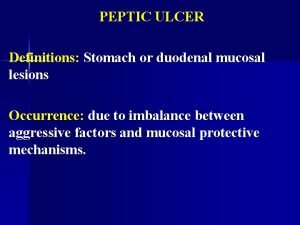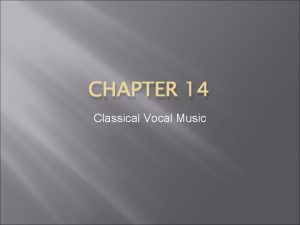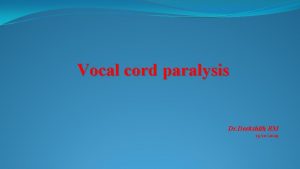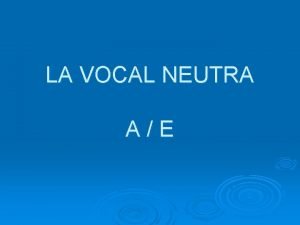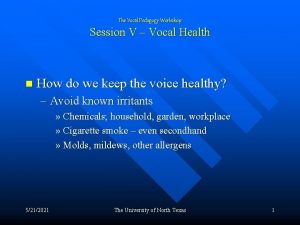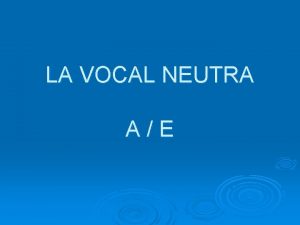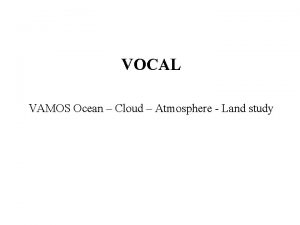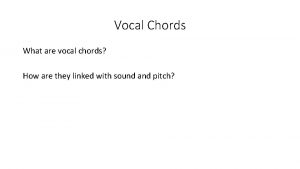Hoarseness Mucosal Vocal Fold Lesions Paresis and LPR







































- Slides: 39

Hoarseness Mucosal Vocal Fold Lesions Paresis and LPR Melanie Giesler, DO

Hoarseness Symptom and disease – symptom of disease process and is an ICD 9 code – the perceived breathiness quality of the voice (Bailey) – a rough or noisy quality of voice (Dorland) – a rough, harsh voice quality (Stedman)

Anatomy: Laryngeal Cartilage

Anatomy: Laryngeal Muscles

Anatomy: Laryngeal Muscles

Anatomy: Laryngeal Innervation

Anatomy: Laryngeal Motion Tension of vocal ligament

Anatomy: Laryngeal Motion Adduction of vocal ligament

Anatomy: Laryngeal Motion Abduction of vocal ligament

Histology

History Onset and duration of vocal symptoms Potential causes or exacerbating influences Other risk factors – – – – – Tobacco Alcohol LPR Dehydration Medications Allergies Voice Abuse – one episode or chronic – teachers/preachers Neurologic Disorders History of Trauma/Surgery

Physical Examination Flexible fiberoptic nasolaryngoscope – Advantages: well tolerated, physiologic, video documentation – Disadvantages: time consuming, expensive, resolution limited by fiberoptics

Physical Examination Videostroboscopy – Advantages: allows apparent “slow motion” assessment of mucosal vibratory dynamics, video documentation – Disadvantages: time consuming, expensive

Benign Vocal Fold Lesions Polyps Nodules Varices and Ectasias Cysts Granulomas Polypoid Corditis/Reinke’s Edema Papillomatosis

Polyps

Polyps

Nodules

Varices and Ectasias

Cysts

Granulomas

Polypoid Corditis (Reinke’s Edema) Extensive swelling of SLP Usually on superior surface of musculomembranous vocal fold Typically bilateral but asymmetric volume Multifactorial cause – Smoking – LPR – Vocal hyperfunction

Polypoid Corditis (Reinke’s Edema) Treatment – – Smoking cessation Antireflux medication Preoperative vocal therapy Surgery Epithelial microflap elevation with SLP contouring and reduction using either cold instruments, Microspot CO 2 laser, or both Vocal ligament should never be visualized Both vocal folds can be treated in one procedure if flap is elevated on superior surface of vocal fold

Polypoid Corditis (Reinke’s Edema)

Papillomatosis Human papillomavirus 6 and 11 Confined to epithelium – Excision should preserve SLP Most commonly found in musculomembranous region, but may extend into arytenoid, ventricle, subglottis

Papillomatosis Surgical treatment – Cold instruments – Microdebrider – Microspot CO 2 laser Resection of lesions inhibits recurrence in 30% of chronic patients

Papillomatosis

Vocal Cord Paralysis

Etiology Causes of Vocal Cord Paralysis in Adults: Cause Unilateral % Bilateral % Surgery 24 26 Idiopathic 20 13 Malignancy 25 17 Trauma 11 11 Neurologic 8 13 Intubation 8 18 Other 5 5 Benninger et al. , Evaluation and Treatment of the Unilateral Paralyzed Vocal Fold. Otolaryngol Head Neck Surg 1994; 111 -497 -508

Evaluation - Electromyography Normal – Joint Fixation – Post. Scar Fibrillation – Denervation Polyphasic – Synkinesis – Reinnervation

Evaluation - Imaging Chest X-ray – Screen for intrathoracic lesions MRI of Brain – Screen for CNS disorders CT Skull Base to Mediastinum Direct Laryngoscopy – Palpate arytenoids, especially when no LEMG

Laryngopharyngeal Reflux (LPR) Other aliases: extraesophageal reflux, reflux laryngitis, posterior laryngitis Contributes up to 50% of laryngeal complaints Backflow of gastric contacts into larynx, pharynx, and upper aerodigestive tract Upper esophageal sphincter (UES) dysfunction Affects 50 million Americans – Present in 4 -10% of those with gastroesophageal reflux disease (GERD) – About 20 -70% with LPR have symptoms of GERD

Upper Esophageal Sphincter C-shaped sling attached to cricoid cartilage – – – Cricopharyngeus Thyropharyngeus Proximal cervical esophagus Innervated by pharyngeal plexus – Vagus nerve Superior laryngeal nerve Recurrent laryngeal nerve – Glossopharyngeal nerve – Sympathetics from superior cervical ganglion

Key Symptoms Cervical dysphagia Globus Respiratory complaints – – – Sore throat Chronic cough Throat clearing Dysphonia Hoarseness Upright (daytime) reflux Heartburn uncommon Normal acid clearance

Comparison to Gastroesophageal Reflux n n n Cervical dysphagia Globus Respiratory complaints ¡ ¡ ¡ n n n Sore throat Chronic cough Throat clearing Dysphonia Hoarseness Upright (daytime) reflux Heartburn uncommon Normal acid clearance n n n n Dysphagia Less respiratory complaints Rare dysphonia Supine (nighttime) reflux Heartburn Delayed acid clearance Regurgitation Esophagitis

Other Symptoms n n n Asthma exacerbation Ear pain Excess throat mucus Halitosis Laryngospasm Neck pain n Odynophagia Postnasal drip Voice complaints ¡ ¡ Breaks Fatigue Longer warmup time Loss of upper singing range

Physical Findings Posterior laryngitis – – Edema Posterior commissure and arytenoids Increased vascularity Erythema Edema – – Infraglottic (pseudosulcus vocalis) Diffuse Ventricular effacement (Belafsky et al, 2001) Mucosal hypertrophy Laryngeal pachydermia (granularity, cobblestone) Ulcers, granulomas, scarring, stenosis

Implications Asthma Bronchiectasis Cervical dysphagia Chronic cough Chronic dysphonia Chronic laryngitis Chronic rhinitis Dental caries Globus pharyngeus Laryngeal carcinoma Laryngeal papillomas n n n n n Laryngomalacia Laryngospasm Laryngotracheal stenosis Obstructive sleep apnea Otitis media Paradoxical vocal-fold motion disorder Recurrent croup Reinke edema Ulceration Vocal fold granulomas

Pediatric Considerations Abnormal crying Anorexia Apnea Chronic cough Chronic nasal pain Dental erosion Dysphagia Irritability Laryngomalacia Nasal obstruction n n n n Otitis media/otalgia Recurrent upper respiratory infections Regurgitation/vomiting Rhinorrhea Sleeping disorders Subglottic stenosis Sinusitis Torticollis (Sandifer’s Syndrome)

Diagnosis Ambulatory 24 -hour double-probe p. H monitoring – – – Current standard Probes above upper and lower esophageal sphincters Detects acidic reflux events only Impedence – – – Multiple electrode pairs on p. H-probe-type catheter Track retrograde bolus transit Measures acidic and nonacidic events No set guidelines lead to controversy and misdiagnoses – – Edema, ventricular effacement, and pseudosulcus vocalis are more common findings Physicians commonly look for posterior laryngitis
 Laryngeal cartilages
Laryngeal cartilages Alveola
Alveola Als betegség kezdeti tünetei
Als betegség kezdeti tünetei Paresis
Paresis Mucosal atomizer device (mad)
Mucosal atomizer device (mad) Stomach mucosal barrier
Stomach mucosal barrier True vocal folds and false vocal folds
True vocal folds and false vocal folds Life saving rules
Life saving rules Esophageal bronchus
Esophageal bronchus Forløbsmarkører
Forløbsmarkører Similarities of vocal styles of india and israel
Similarities of vocal styles of india and israel What is hoarseness
What is hoarseness What is hoarseness
What is hoarseness Primary and secondary lesions of skin
Primary and secondary lesions of skin Pie on the floor visual field defect
Pie on the floor visual field defect Extrapyramidal vs pyramidal
Extrapyramidal vs pyramidal Describing skin lesions
Describing skin lesions Premalignant lesions of esophagus
Premalignant lesions of esophagus Olneys lesions
Olneys lesions Difference between pyramidal and extrapyramidal tract
Difference between pyramidal and extrapyramidal tract G j mount classification
G j mount classification Amiante
Amiante Classification of white lesions of oral cavity
Classification of white lesions of oral cavity Dont touch lesions
Dont touch lesions Glossopharyngeal nerve lesion
Glossopharyngeal nerve lesion Chapter 17 oral pathology short answer questions
Chapter 17 oral pathology short answer questions Pr��ca it projektov�� mana����r
Pr��ca it projektov�� mana����r Scattered white matter lesions
Scattered white matter lesions Daughter mother grandmother pancreatic lesions
Daughter mother grandmother pancreatic lesions Periradicular diseases
Periradicular diseases Visual fields
Visual fields Convergence insufficiency athens
Convergence insufficiency athens White lesions
White lesions Lésions
Lésions Vesiculobullous lesions
Vesiculobullous lesions Leukoedema
Leukoedema Two big drums similar to japanese
Two big drums similar to japanese Fleuty classification of fold
Fleuty classification of fold Folds faults and joints
Folds faults and joints Axillary folds
Axillary folds

